
a web page by Don Roberson |
FRIGATEBIRDS Fregatidae |
|
 |
Oh people, look among you —Jackson Browne Of all the songwriter-singers, I think Jackson Browne is my favorite. I've heard this song a million times, and each time I can't help but think of some tropical place with a frigatebird hanging in the sky way overhead, wings out-stretched. Maybe I'm the only one with that image — but it has been a vivid image for a long long time. It can be a male Lesser Frigatebird (above), soaring above Bali, or a young Great Frigatebird (left) in the eastern tropical Pacific, but it is some place sultry and warm. For me, frigatebirds evoke the tropical oceans. |
However, the piratical habits of frigatebirds is wildly overstated. Their primary prey is flying-fish which they catch directly for themselves (Orta 1992). |
During the day they also sit and preen more hours on end, especially if they find the top of a sailboat or a buoy as a place to sit. Frigatebirds are unusual among seabirds in that they will drink fresh water when it is available, dipping down to scoop up the water in their bills (Orta 1992). |
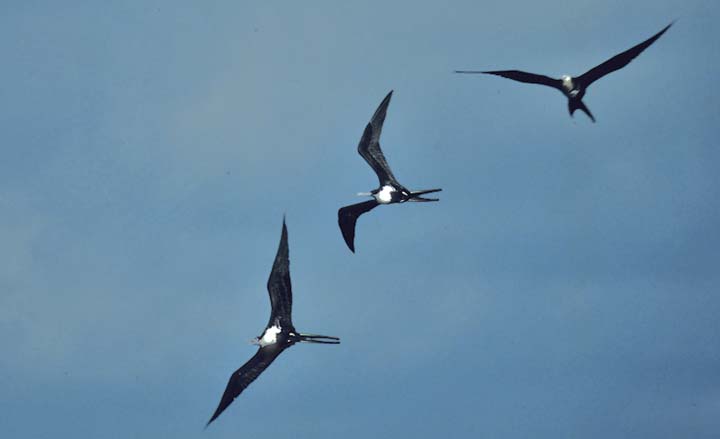 |
Frigatebirds breed on islands, usually in large colonies. Their breeding cycle is one of the longest among seabirds, as chicks are slow to develop. Pairs can only successfully fledge young every other year. The courtship display is spectacular, with males inflated inflating their bright red gular pouches and spreading their wings to catch the light. Females can see these displays from miles away. This behavior is similar for all five species. Frigatebirds are restricted to tropical oceans and their islands. Magnificent Frigatebird (below; an adult female) lives in the New World tropics and off west Africa. Great Frigatebird is widespread across the tropical Pacific and Indian oceans. Lesser Frigatebird is also widespread in the western Pacific, and around islands in the Indian and south Atlantic oceans. |
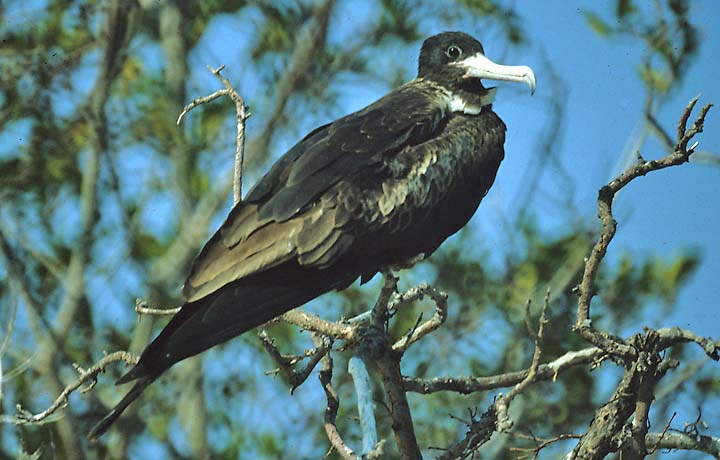 |
The two final species are more local. Ascension Frigatebird Fregata aquila is found only around its breeding island of Ascension in the south Atlantic. The world population is less than 10,000 birds, and it is considered Vulnerable (Birdlife International 2000). Christmas Island Frigatebird F. andrewsi breeds only on Christmas Island in the eastern Indian Ocean, but disperses at sea around the Greater Sundas. The population is quite small (only ~1600 pairs), and it is considered a critically Endangered species (Birdlife International 2000). Hurricanes and typhoons have carried all
species of frigates far from their usual climes, so the assortment of
vagrants worldwide is very impressive. Magnificent reaches California
with some small regularity, but there are also records of Great and
Lesser here as well. A Great reached Oklahoma, and Lessers have been
confirmed from Wyoming, Michigan, and Maine! Identification of vagrants
can be complex. Howell (1994) dealt with the Magnificent vs. Great
problem; James (2004) considered difficulties among the Great, Lesser,
and Christmas Island triad. |
Bibliographic note: There is no "family book" per se, but a fine introduction to this family, with some great photos, is in Orta (1992). Literature cited:
|
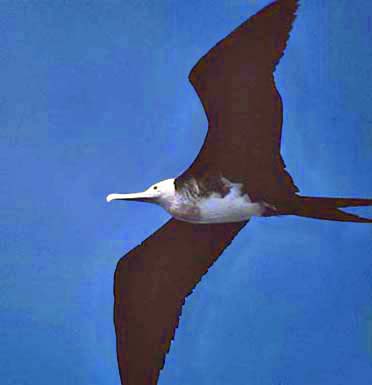
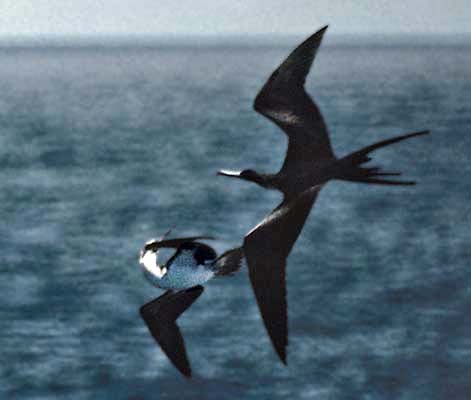 Frigatebirds
are, indeed, a small family of large piratic birds of tropical oceans.
Beyond their long wings and aerial agility, they are best known for
their kleptoparasitism on other seabirds. Frigates harass other
seabirds until the cough up the prey they have caught, such as a fish,
and then snatch that sustenance for themselves. Favored targets are
tropical boobies: this female Magnificent Frigatebird
(right) is harassing a Blue-footed Booby near the Galapagos. During a
four-month research cruise around the eastern tropical Pacific, we
noticed that specific frigatebirds had preferred targets: Magnificent
focused mostly on Blue-footed Boobies while Great aimed predominately
at Red-footed Boobies. Great Frigatebird and Red-footed Booby are
predominately offshore species, so this preference matched their
primary habitats.
Frigatebirds
are, indeed, a small family of large piratic birds of tropical oceans.
Beyond their long wings and aerial agility, they are best known for
their kleptoparasitism on other seabirds. Frigates harass other
seabirds until the cough up the prey they have caught, such as a fish,
and then snatch that sustenance for themselves. Favored targets are
tropical boobies: this female Magnificent Frigatebird
(right) is harassing a Blue-footed Booby near the Galapagos. During a
four-month research cruise around the eastern tropical Pacific, we
noticed that specific frigatebirds had preferred targets: Magnificent
focused mostly on Blue-footed Boobies while Great aimed predominately
at Red-footed Boobies. Great Frigatebird and Red-footed Booby are
predominately offshore species, so this preference matched their
primary habitats. 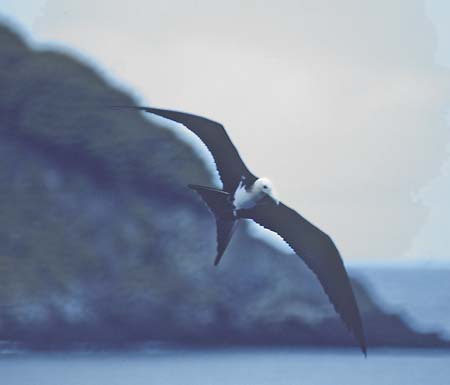 While
frigatebirds sail far out to sea, they cannot land on the water, so
most of their roosts are on land. In this shot of a juvenal Great Frigatebird
(left) we can see Cocos Island, some 300 nmi SW of Costa Rica, in the
background. Frigatebirds can be highly gregarious at night roosts, but
then they disperse to forage mostly alone at dawn. Their prey is
diurnal so they forage only during the day. However, when schools of
fish are found, the abundance of food can attract dozens of birds: the
three Great Frigatebirds (below) were part of a much larger gathering around a tuna-porpoise association far out to sea.
While
frigatebirds sail far out to sea, they cannot land on the water, so
most of their roosts are on land. In this shot of a juvenal Great Frigatebird
(left) we can see Cocos Island, some 300 nmi SW of Costa Rica, in the
background. Frigatebirds can be highly gregarious at night roosts, but
then they disperse to forage mostly alone at dawn. Their prey is
diurnal so they forage only during the day. However, when schools of
fish are found, the abundance of food can attract dozens of birds: the
three Great Frigatebirds (below) were part of a much larger gathering around a tuna-porpoise association far out to sea.